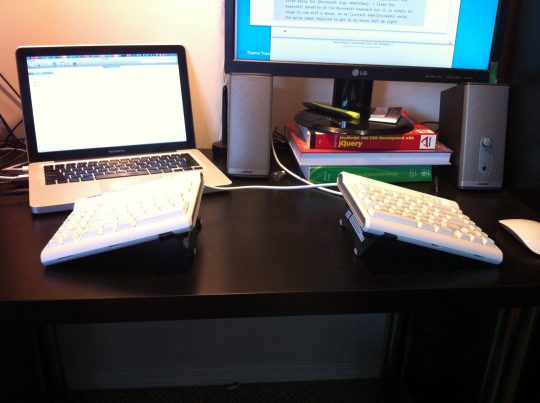I’ve been looking for the right keyboard for a while, most recently reviewing the Microsoft Arc. The Arc was a decent keyboard but left my wrists a bit sore still and the keys on the outer edges were lacking.
My latest keyboard is the Kinesis Freestyle Solo for Mac.
Update August 7, 2014: This review is about the V1 keyboard. I now also own the V2 keyboard and it’s still awesome. The keys are a little ‘softer’ but I don’t mind it. The V2 also has 2 USB 2.0 ports on the back of the keyboard. I wish they were 3.0 ports but they work fine. Now I just swap out the ‘dirty’ one every 6 months and wash the other one in the dishwasher. Kinesis Freestyle V2.
Also note that the VIP lifters from a V1 keyboard will ‘fit’ but they have a gap since the V2 is thiner. This leaves the keyboard a bit unstable. Nothing terrible, but get the VIP3 lifters to get the correct fit.
tl;dr
I love it but if you use Dvorak there are one or two small issues, namely around the special function keys on the left side. Oh and it has a cord.
The Specs
The Kinesis is my latest foray in to ergonomic keyboards, the first being the Microsoft Ergo 4000. I liked the ergonomic benefits of the Microsoft keyboard but it is simply to large to use with a mouse, on my current desk setup. The extra reach required to get to my mouse left my right shoulder strained at the end of some days. Since I have dislocated my shoulder a couple times already I’m very careful with how I use it, I’d rather not injure it again.
The most striking feature of the Kinesis is the fact that it is fully split, the two halves of the keyboard are tethered by a cable so you can move them up to 8 inches apart. For me this means that my arms are almost entirely straight out in front of me. If your need a bit more, there is a version with a 20 inch seperation as well.

This total separation of the keyboard halves also means that you can easily customize the rise of the keyboard. I invested in the V3 lifters which offer 3 positions ranging from 5 – 30 degrees of tilt. If you don’t like the V3 then you can also use the VIP, the Incline or the Ascent.
The VIP is similar to the V3 but includes wrist rests. It only has a maximum height of 15 degrees and a minimum height of 10 degrees compared to the 5, 10, 15 range of the V3.
Update May 8, 2012: It used to say 5, 15, 30 for the degree of raise, which was incorrect. Thanks to Sam for bringing it up in the comments.
The Incline uses the pin holes in the back of the keyboard and puts the keyboard on a tray making it similar to a regular ergonomic keyboard. You can still change the angle that the halves sit in relation to your hands but the tilt is set.
The Ascent is probably the most radical accessory. It places the two halves of the keyboards totally vertical which places your wrists in their ‘natural’ position. I am not quite brave enough to try it though.
You can view all the videos for the different accessories on the Kinesis site. Unfortunately, just like the sucky Kinesis site the videos are only okay as well, and I can’t find any to embed.
If you’re not in to having the two halves of the keyboard fully apart then there is also a pin that joins the top of the two halves and gives them a more traditional erognomic profile, but still allow you to change how the two halves meet your hands. This pin can be used with both the V3 and the VIP accessories. While I ended up with the halves totally apart, I started with the pin in and even that helped releave wrist pain. The pin is easily removed via the two sliders at the top of the keybard halves for you to try them apart.
Loves
The thing I love the most about the keyboard is the full seperation of the parts and the 30 degrees of lift. The combination of them has entirely removed any lingering wrist pain I had. For me the full 30 degrees is ideal when I’m typing. When I pull my tablet out I push the two halves together and reduce the angle to 15 degrees. I’ve simply found working in Photoshop, Illustrator, and Screenflow easier with the tablet and the halves together.
A close second is the light key action without feeling ‘mushy’. The keys press easy but still provide a nice response. In theory, according to Kinesis, this reduction in key force reduces the chance of typing related injury. Kinesis says that the Microsoft keyboards have a 60 gram key force and the Freestyle has 45 grams. I have no scientific knowledge to back up their claims, I just know the keys feel nice.
The Mac version of the keyboard comes with all of the functions keys mapped as they would be on a Mac, without the need for special drivers. So just like a Mac you can control your sound, play/pause, display brightness, and Exposé.
I addition to the standard F keys being mapped as they would on a Mac, Kinesis provides cut, copy, paste, back, forward, and a few other function keys on the left hand side of the keyboard. They do this to reduce the need for ’awkward’ hand gestures to get to ⌘X or ⌘V.
Another props I’ll give out is to Kinesis themselves. Their site sucks but the customer service is awesome. I called them 2 days before Christmas 2011 and someone picked up right away to offer advice on the lifters I’d most likely prefer. In addition to that, they were closed in theory between Christmas and New Year’s so I did not expect my keyboard to go in the mail till early 2012, but I guess their shipping department didn’t get the same vacation time. I got my keyboard before the New Year rang in and was typing happy for all of 2012.
Issues
While the fancy function keys on the left side of the keyboard work just fine when using the normal QWERTY keyboard layout, they break entirely when using a Dvorak layout which is what I use. This is where the ’simplicity’ of a lack of keyboard driver is really something that is annoying. Unlike some of there other keyboards, they do not offer any option for Dvorak users to remedy the issue. It seems to me that the reason the keys don’t work is that they are tied to the press of a key number (assuming x is key number 89, which it may or may not actually be) and not to the letter press. So when you try to cut something with the special function key you are actually quoting the application since the system interprets the key press (89) as the press of the Q key. Ultimately this is a bit annoying but I never used the special function keys anyway so I don’t consider it a deal breaker, it would just be nice if there was a fix for anyone that wants it.
I did end up emailing Kinesis for confirmation, there is no way to fix the driverless hot keys for a Dvorak layout. Kinesis says that they are Macros stored on the keyboard.
Update May 2, 2012: Kinesis followed up again and for $10 they said they could redo the firmware on the keyboard to make the macros work with Dvorak. This of course would break them on QWERTY. So if you’re on Dvorak and want the function keys make sure you call them and get the different firmware setup. They actually said to get in touch with Tech Support (not Sales) for this particular request. I should also give them another props on service since they took the initiative to follow up again on an issue that I thought was closed.
I hate cords and unfortunately there is no option for either a Bluetooth or wireless dongle for the keyboard. I find the other benefits of the keyboard worth the trade off but it’s annoying still. I’d happily pay another $50 to loose the wire from the keyboard to the computer.
Finally, why is the keyboard white? I guess Apple decided that white is the right colour for stuff but not a keyboard. White just looks dirty quick. Yes I know that the colour has no real effect on how dirty a keyboard gets but you can see it with the white version sooner than with a black one (which is the colour of the Windows version of the keyboard). I like my keyboards clean (but OCD in that regard) so I end up dish washing my keyboard every other month at least.
Something else to remember for those not used to a fully split keyboard is that you need to learn how to type on it. If you’re a touch typer than the 6 is on the wrong hand. Certainly not a huge issue but something to make note of. I also found that I had trouble hitting the ’b’ for a while. I’ve heard that each person has trouble with a slightly different key on the split. I never found it a big enough deal to stop using the keyboard and within a few days it was no issue. The ergonomic benefits of a split keyboard were noticeable right away which made the typing issue something that was totally worth working through.
Overall I love this keyboard. After 3 months using it I find any other desktop keyboard lacking. The keys don’t feel as nice and the lack the fully separated halves which help greatly with any wrist pain you may have. Even my ergonomic Microsoft, which is split, doesn’t compare to the comfort of being able to fully separate the halves.
Photo by: songzhen

2 responses to “Kinesis Freestyle Solo Review”
Is it 30° on the V3? Kinesis indicates only 15° on their site. I’d like more than 15°, so if it’s in fact 30°, I’ll get the V3 instead of the VIP.
Nope, you’re right it’s 15 not 30. I’ll make that correction.